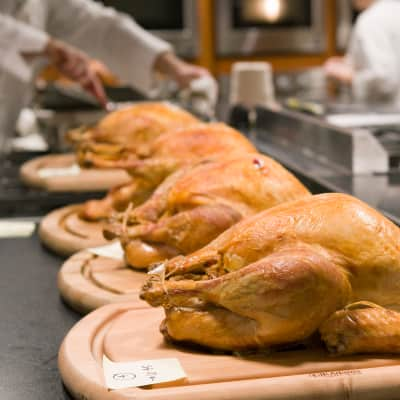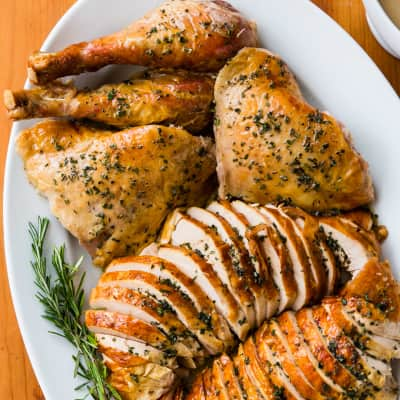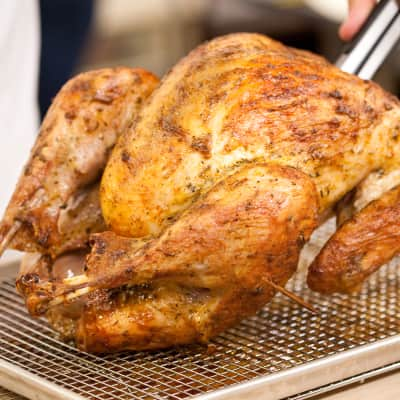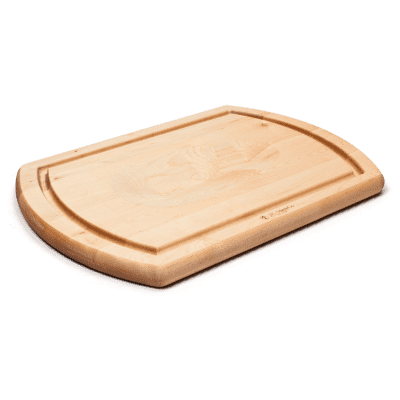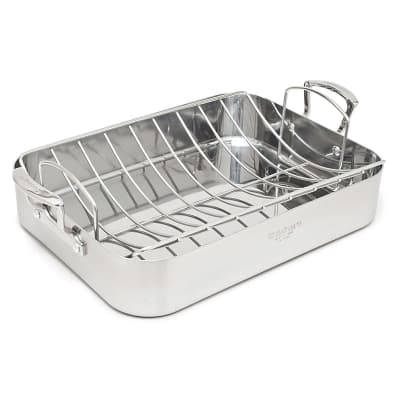VIDEO: Watch Editor in Chief Dan Souza and Senior Editor Lan Lam give you the lowdown on how to make your best Thanksgiving turkey, ever. And check out our comprehensive Thanksgiving Guide for all the information you need to make this your most successful Turkey Day dinner yet.
Everything You Need to Know to Make the Perfect Thanksgiving Turkey
Published Nov. 1, 2017.

How to Shop for a Thanksgiving Turkey
When it comes to buying a turkey at the supermarket, the options seem endless and the labels confusing. Our team has sampled dozens of turkeys over the years and talked with experts to identify which birds deserve the spotlight on your Thanksgiving table. Here’s what we’ve learned:
Fresh Isn’t Always Best:
Unless you’re buying a turkey fresh from a local farm, a frozen turkey is the better bet. Why? When turkeys are commercially frozen, the process is quick, which prevents large ice crystals from forming and damaging the meat. Turkeys labeled “fresh” may be chilled to as low as 26 degrees, meaning that even though the entire turkey will not freeze, tiny ice crystals can still form in the meat. If these crystals melt (which can happen if the temperature fluctuates during transport, even driving home from the grocery store), they can merge with neighboring crystals, refreeze when the turkey is returned to the freezer, and puncture the meat, allowing juices to escape during cooking and the meat to cook up dry and tough.
Bigger Isn’t Better:
The bigger the bird, the harder it is to get the white and dark meat to cook evenly. Plus, some ovens can’t accommodate large turkeys. We recommend buying a bird that weighs between 12 and 14 pounds. If you’re feeding a crowd, consider supplementing the whole bird with turkey parts, like whole breasts.
Roast Whole Turkey Breast with Gravy
Feeding a crowd? The turkey breast in this recipe cooks in as little as 1½ hours. By removing the backbone, the turkey breast sits flat in the oven, which leads to even browning and more stability during carving. Roasting first at a lower temperature prevents the delicate breast meat from overcooking. A final high-heat blast at the end of cooking produces crisp, burnished skin.
Roast Whole Turkey Breast with Gravy
A perfectly cooked, crispy-skinned turkey breast can be just the ticket for a smaller holiday gathering—particularly if it comes with gravy.Check the Ingredient List:
Many supermarket turkeys are injected with salty liquid that’s meant to enhance flavor and moisture: It seasons the meat and changes its protein structure so it holds more water. When phosphates are included, they allow the meat to hold even more water. This type of processing may sound promising—after all, we brine turkey and chicken in the test kitchen to improve flavor and moistness. But we’ve found that injected birds (these are often labeled “self-basting”) can contain funky-tasting spices and seasonings and their retained liquid (up to 9.5 percent) gives them a curiously “gummy” and “mushy” texture. Furthermore, if you purchase a treated bird you’re actually paying for all that retained water weight, as most turkeys are sold by the pound. The bottom line? For the best holiday bird, check the ingredient list, avoid those containing anything other than “turkey,” and follow our instructions for brining or salting.
OUR FAVORITE SUPERMARKET TURKEY
Our winner, Mary’s Free-Range Non-GMO Verified Turkey, which is from the same company that produces our winning chickens and heritage turkeys, lists "turkey" as the only ingredient, has relatively high fat levels, and is fed a vegetarian diet. As a result, it had “clean,” “robust” turkey flavor.
Our Best Buy is the Plainville Farms Young Turkey, which tasters described as "amazingly flavorful" with "rich, meaty" dark meat.
The Best Supermarket Turkey
The holidays are no time to gamble on a bird that cooks up dry and bland—or, worse, exhibits off-flavors.Pretreating Turkey: Salting Versus Brining
Don't Forget to Thaw Your Frozen Turkey
Defrost your turkey in the refrigerator, calculating one day for every 4 pounds of bird. If you’re planning to salt or brine and air dry your turkey, don’t forget to account for that time in your Thanksgiving schedule. For example, if you’re planning to salt your 12-pound turkey for at least 24 hours, don't forget to account for that time, too.
- Emergency Quick-Thaw: Place turkey in its wrapper in a bucket filled with cold water and thaw for 30 minutes per pound. Change water every 30 minutes to prevent bacteria growth.
We’re big proponents of pretreating your turkey by either salting or brining it before roasting. Both techniques season and enhance juiciness in lean meat like turkey. Which method you use depends on how much time and space you have, and how much you prioritize really crisp skin. (Note: If using a self-basting turkey (such as a frozen Butterball) or a kosher turkey, do not salt or brine your bird.) Here’s how the two methods compare:

SALTING (APPLYING SALT DIRECTLY TO TURKEY, UNDER THE SKIN)
- Pros: Requires less fridge space; helps dry out skin so it crisps during roasting
- Cons: Slower (24 to 48 hours)

BRINING (SOAKING IN A SALT SOLUTION)
- Pros: Faster (6 to 14 hours)
- Cons: Takes up a lot of fridge space; adds extra moisture that can prevent skin from crisping
Ready to get started? Click here for detailed directions on how to brine and how to salt a turkey.

For Extra-Crisp Skin, Air-Dry Your Bird
Air drying your turkey removes moisture from the exterior, producing very crisp skin.
- If you’re brining your turkey:
- After brining, rinse turkey and pat dry with paper towels. Place turkey breast-side up on a flat wire rack set over a rimmed baking sheet and refrigerate, uncovered, 8 to 24 hours. Proceed with your recipe.
- If you’re salting your turkey:
- After applying salt, place turkey, breast-side up, on a flat wire rack set over a rimmed baking sheet. Refrigerate, uncovered, for 24 to 48 hours. (The salt penetrates the turkey at the same time the skin dries.) Proceed with your recipe.
Our New Favorite Way to Roast a Turkey
It’s time to roast that bird. Our Easier Roast Turkey and Gravy recipe uses a unique setup to produce white and dark meat that finish cooking concurrently, along with extra-crisp skin.
A New Twist on Roasting Turkey: The Setup
- Preheat a baking stone, with roasting pan placed on top, for at least 30 minutes in a hot oven.
- Drizzle preheated roasting pan with oil.
- Place turkey, breast side up, into preheated roasting pan (it will sizzle).
- Cover breast with aluminum foil to protect from overcooking.
- Return roasting pan to oven on top of preheated baking stone.
- Roast at a higher temperature for first 45 minutes.
- Remove foil. Lower the oven temperature and roast until turkey is done (see next section).
Why It Works: The baking stone transfers heat directly to the bottom of the roasting pan, which is in contact with the turkey’s thighs and drumsticks. That extra boost of heat causes the dark meat, which cooks to a higher temperature (175 degrees), to finish cooking concurrently with the more delicate white meat. That means no more overcooked turkey, and no need to awkwardly flip the bird in the roasting pan to evenly cook the breasts and thighs.
Our Favorite Turkey Roasting Equipment
A few tools help guarantee a perfectly cooked bird, every time.
- Roasting Pan: Our winner is made from tri-ply stainless steel; features comfortable, easy-to-grip handles; and boasts a price that won’t break the bank.
- Baking Stone: Roasting your turkey in a pan set atop a baking stone gives the dark meat an extra boost of heat, so it’s done at the same time as the white. Our favorite is tough and durable.
- Oven Thermometer: Home ovens are notoriously inaccurate. Our winner guarantees precise, reliable results.
Do You Need to Truss Your Turkey?
Trussing prevents the turkey’s legs from splaying open, which could make them cook unevenly. If the turkey has a pocket of skin at the tail end, we tuck the legs in there. If not, we tie the legs together with kitchen twine.
Don't Baste Your Bird
Contrary to popular belief, basting doesn’t make for moister meat and is detrimental to crisp skin (remember all that time you spent air drying your turkey?). Basting also requires you to frequently open and close the oven door, lowering the oven temperature and slowing cooking.
How To Know When Turkey Is Done
Don’t depend on that little pop-up thermometer that comes pre-inserted into the turkey; they’re unreliable and can lead to underdone or overcooked birds. The most accurate way to gauge the doneness of a turkey is to take its temperature with an instant-read thermometer.
How to Take Your Turkey's Temperature
Breast: Insert the thermometer from the neck end, holding it parallel to the bird. (Avoid hitting the bone, which can give an inaccurate reading.) It should register 160 deg

Thigh: Insert the thermometer at an angle into the area between the drumstick and breast away from the bone. It should register 175 degrees.

How to Carve a Turkey
Rather than carving the Thanksgiving bird tableside, we recommend tackling this messy job in the kitchen. After your turkey’s rested for about 45 minutes (uncovered, to keep the skin crisp), gather your chef’s knife and your carving board and follow our step-by-step instructions for how to carve a turkey like a pro.
There you have it—everything you need to know to make a picture-perfect Thanksgiving turkey, whether you're serving a small group or a whole crowd.
From planning the menu, to shopping for ingredients, to setting a timeline for the big day, our Thanksgiving Guide has all the information you need to make this your most successful holiday dinner yet, whether it's your first time hosting or you want to pull out all the stops.

